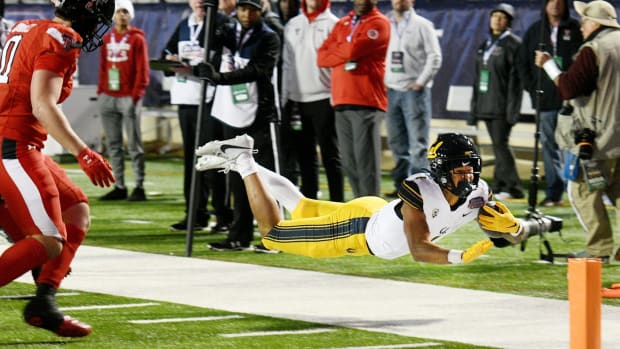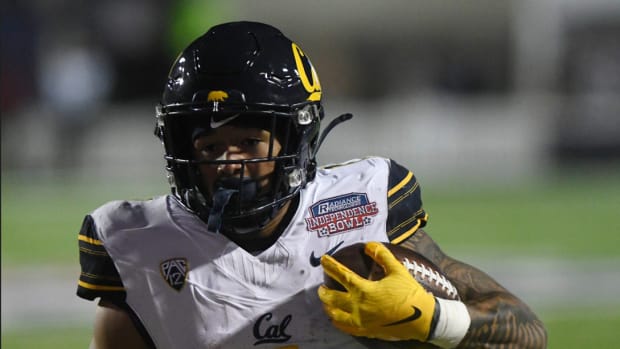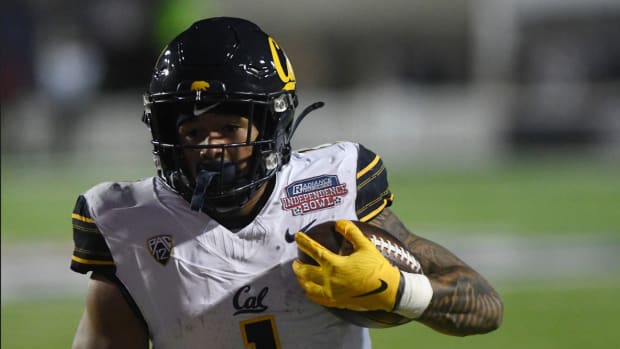Will 12-Team College Football Playoff Benefit the Pac-12?
It appears a 12-team playoff will replace the four-team College Football Playoff in the near future, possibly as early as the 2023 season and probably no later than 2026. So will this be a godsend for the Pac-12 or another devastating blow?
The official approval of the plan is yet to come, but recommendations, such as this one by a College Football Playoff working group, typically get rubber-stamped into existence, so we can assume it will be approved in the June 22 meeting of the 11 college presidents who make up the CFP's board of managers.
The proposal came from the four-person group of Big 12 commissioner Bob Bowlsby, Mountain West commissioner Craig Thompson, SEC commissioner Greg Sankey and Notre Dame athletics director Jack Swarbrick. Though not represented in that group, the Pac-12 was very much in favor of the expansion, since it did have a team in the four-team College Football Playoff in any of the past four seasons. It’s the only Power 5 conference that has not had at least two representatives in that four-year span.
But will the expansion to 12 teams really help the Pac-12, or could it bring additional embarrassment to the conference.
The first thing to note is that if the recommended 12-team format had been in effect for the 2020 season, the Pac-12 would not have had a team in it.
The model calls for the six conference champions with the highest ranking to get a berth. Champions of the Southeastern Conference (Alabama), ACC (Clemson), Big Ten (Ohio State), Big 12 (Oklahoma), American (Cincinnati) and Sun Belt (Coastal Carolina) all ranked in the top 12 of the final CFP standings, while Pac-12 champion Oregon was well down the list at No. 25.
After those six teams are invited, six at-large teams are added. Presumably they would be the highest-ranked teams in the final CFP standings. USC was the highest ranked Pac-12 team at No. 17, giving it no chance to make the 12-team field.
So a 12-team national playoff would have humiliated the Pac-12 further.
Of course, the 2020 season was not a good example since the shortened season and the more restrictive protocols in the West made it more difficult than usual for Pac-12 teams to raise their national profile. Plus, the CFP selection committee would no doubt scrutinize rankings five through 20 more closely than it does now if eight additional teams would be part of the playoffs.
However, recent post-spring rankings suggest the Pac-12 would be in danger of not getting a team into a 12-team playoff in 2021 if the model came into being immediately.
The Pac-12 is considered wide-open in 2021 and no team is ranked higher than 10th (Oregon) in ESPN’s post-spring power rankings. With five conferences (SEC, ACC, Big Ten, Big 12, American) represented by teams ranked above the Ducks and a sixth conference not far behind with Louisiana of the Sun Belt at No. 16, a Pac-12 conference without a dominant team would be on the fringe of making a 12-team field -- if these projections turn out to be accurate.
The Sporting News preseason top 25 is similar, with no Pac-12 team ranked higher than 12th (USC), five conferences having a representative ranked higher than that, and Coastal Carolina of the Sun Belt at No. 23, not too far behind USC and within range of being the sixth-highest ranked conference champion.
The point is, the 12-team model has the potential to further devalue Pac-12 football.
Realistically, though, the Pac-12 is likely to get at least one team, and probably two, into a 12-team playoff every year. Besides the fact that expansion will generate more interest in college football’s national championship run for everyone, it will be particularly helpful for the Pac-12.
Based on final CFP rankings, the Pac-12 would have had two teams in a 12-team field in 2019, one in 2018, two in 2017, three in 2016, one in 2015 and two in 2014, the first year the four-team College Football Playoff went into effect.
Having a dog in the fight would make all the difference, as Bowlsby, a former Stanford athletic director and current Big 12 commissioner, noted:
"We probably underestimated -- 'we' being the A5 commissioners -- how difficult it was to be on the outside looking in on a four-team playoff," Bowlsby told ESPN. "I think that was a factor. There was certainly lots of consternation around those of us that were left out at one time or another, so I think that was an element of it."
Three possible drawbacks to a 12-team playoff:
1. Two Pac-12 teams could face each other in the first round, which would have happened in 2019. That would detract from general interest and minimize regular-season results. Imagine two Pac-12 teams facing each other during the regular season, again in the conference championship game and again in the 12-team national championship playoff. Well, the SEC faces that possibility nearly every year.
2. The Pac-12’s traditional tie-in with the Rose Bowl could be in danger. After the four first-round games are played at the site of the higher-ranked team (a point of controversy), the sites of the four quarterfinal games and the two semifinal games have not been determined. But it stands to reason they would be played at what are now the six major bowls – Rose, Cotton, Peach, Orange, Sugar and Fiesta. The idea of the Rose Bowl hosting the Pac-12 champion in most years would probably go by the wayside. The Rose Bowl's traditional 2 p.m. Jan. 1 time slot may be in jeopardy too if it hosts a semifinal game the second week of January.
3. The Pac-12 could re-establish itself as a prominent football conference in the three to five years before the 12-team format is installed. Two Pac-12 teams were ranked in the top four of the final AP polls in both 2010 and 2016 and three wound up in the top seven in 2011. So it was not long ago that the Pac-12 was a football powerhouse. If the conference returns to that standard, the Pac-12 might prefer an eight- or four-team playoff system to focus more attention on its resurgence and dominance.
The 12-team plan would give a middling Pac-12 team like Cal hope of getting into the national-title playoff, even though it would seem like a long shot at the moment.
The Golden Bears did not finish in the top 25 in any of the seven CFP rankings since the four-team playoff format came into existence. And Cal has not ended a season nationally ranked since 2006, when it finished 18th in the final BCS rankings before winding up at No. 14 in the final AP poll following a bowl victory. The Bears would have been left out of a 12-team postseason playoff.
However, Cal would have loved to have had a 12-team national championship playoff in 2004, when the Bears finished the regular season ranked fourth in both human polls, but wound up fifth in the BSC standings, preventing Cal from getting the desired Rose Bowl berth, which went to Texas instead.
In a 12-team playoff field, that Cal team would have been ranked fourth or fifth in the final CFP standings and would have been an easy selection for one of the six at-large berths, even though USC was the conference champion.
The 2004 Cal team -- with Aaron Rodgers at the helm, All-American J.J. Arrington and Marshawn Lynch running the ball and long-time NFL players Brandon Mebane, Lorenzo Alexander and Matt Giordano on defense -- took eventual national champion USC down to the final seconds in Los Angeles in the Bears’ only regular-season loss and would have been a threat to win it all.
They might even have played in the Rose Bowl.
Here is how a 12-team playoff would played out in the past seven seasons, based on final CFP rankings (with Pac-12 teams in bold):
,
2014
Alabama (1) — first-round bye
Oregon (2) — first-round bye
Florida State (3) — first-round bye
Ohio State (4) — first-round bye
No. 5 Baylor vs. No. 12 Boise State (winner plays Ohio State)
No. 6 TCU vs. No. 11 Kansas State (winner plays Florida State)
No. 7 Mississippi State vs. No. 10 Arizona (winner plays Oregon)
No. 8 Michigan State vs. No. 9 Mississippi (winner plays Alabama)
.
2015
Clemson (1) — first-round bye
Alabama (2) — first-round bye
Michigan State (3) — first-round bye
Oklahoma (4) — first-round bye
No. 5 Iowa vs. No. 12 Houston (winner plays Oklahoma)
No. 6 Stanford vs. No. 11 TCU (winner plays Michigan State)
No. 7 Ohio State vs. No. 10 North Carolina (winner plays Alabama)
No. 8 Notre Dame vs. No. 9 Florida State (winner plays Clemson)
.
2016
Alabama (1) — first-round bye
Clemson (2) — first-round bye
Washington (3) — first-round bye
Penn State (4) — first-round bye
No. 5 Ohio State vs. No. 12 Western Michigan (winner plays Penn State)
No. 6 Michigan vs. No. 11 Florida State (winner plays Washington)
No. 7 Oklahoma vs. No. 10 Colorado (winner plays Clemson)
No. 8 Wisconsin vs. No. 9 USC (winner plays Alabama)
.
2017
Clemson (1) — first-round bye
Oklahoma (2) — first-round bye
Georgia (3) — first-round bye
Ohio State (4) — first-round bye
No. 5 Alabama vs. No. 12 UCF (winner plays Ohio State)
No. 6 Wisconsin vs. No. 11 Washington (winner plays Georgia)
No. 7 Auburn vs. No. 10 Miami (winner plays Oklahoma)
No. 8 USC vs. No. 9 Penn State (winner plays Clemson)
.
2018
Alabama (1) — first-round bye
Clemson (2) — first-round bye
Oklahoma (3) — first-round bye
Ohio State (4) — first-round bye
No. 5 Notre Dame vs. No. 12 Penn State (winner plays Ohio State)
No. 6 Georgia vs. No. 11 LSU (winner plays Oklahoma)
No. 7 Michigan vs. No. 10 Florida (winner plays Clemson)
No. 8 UCF vs. No. 9 Washington (winner plays Alabama)
.
2019
LSU (1) — first-round bye
Ohio State (2) — first-round bye
Clemson (3) — first-round bye
Oklahoma (4) — first-round bye
No. 5 Georgia vs. No. 12 Memphis (winner plays Oklahoma)
No. 6 Oregon vs. No. 11 Utah (winner plays Clemson)
No. 7 Baylor vs. No. 10 Penn State (winner plays Ohio State)
No. 8 Wisconsin vs. No. 9 Florida (winner plays LSU)
.
2020
Alabama (1) — first-round bye
Clemson (2) — first-round bye
Ohio State (3) — first-round bye
Oklahoma (4) — first-round bye
No. 5 Notre Dame vs. No. 12 Coastal Carolina (winner plays Oklahoma)
No. 6 Texas A&M vs. No. 11 Indiana (winner plays Ohio State)
No. 7 Florida vs. No. 10 Iowa State (winner plays Clemson)
No. 8 Cincinnati vs No. 9 Georgia (winner plays Alabama)
.
Cover photo of Oregon celebrating 2020 Pac-12 championship is by Kirby Lee, USA TODAY Sports
.
Follow Jake Curtis of Cal Sports Report on Twitter: @jakecurtis53
Find Cal Sports Report on Facebook by searching: @si.calsportsreport or going to https://www.facebook.com/si.calsportsreport




